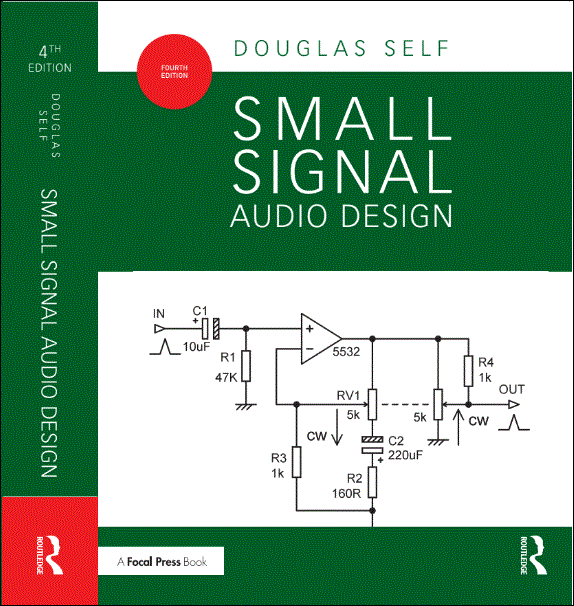Small Signal Audio Design: 4th edition
|
| |
Page updated:
22 Jan 2024
Available now
|  
| |
Here is the Fourth Edition of my book on with audio small signal design, which is the amplification and control of audio in the analogue domain, where the operations are performed with op-amps or discrete transistors, usually working at a nominal level of 1 Volt or less. It is a unique collection of detailed information on small-signal audio, and has now been enlarged by 50%. All of the new material is wholly original and derived from my own researches; most of it has never been published before.
From any good/big bookshop, or via Routledge/Taylor & Francis or Amazon. See links below:

816 pages
ISBN: 978-1-032-36627-2 Hardback
ISBN: 978-1-032-36625-8 Paperback
ISBN: 978-1-003-33298-5 ebook
Published by Focal Press, an imprint of Routledge/Taylor & Francis
Learn more about purchasing this book from:
The Taylor & Francis Site
The Routledge site
Amazon UK
.
So much has been added to this edition that it is difficult to summarise, but the new material includes:
- Ch 1: Balanced and unbalanced signals; the deeper meaning
- Ch 1: Internally balanced design
- Ch 1: 600 Ohm lines
- Ch 1: Opamp-based power amplifiers
- Ch 1: Tin and its uses
- Ch 1: Printed Circuit Board technology
- Ch 1: Microphony in electrolytic capacitors
- Ch 3: Emitter-follower stability
- Ch 3: JFET source-followers
- Ch 3: CFP-follower stability
- Ch 3: Three-transistor shunt-feedback amps with current-injection
- Ch 4: More opamp types examined
- Ch 4: Opamp output biasing for reduced distortion
- Ch 6 Amplitude peaking and Q in lowpass and highpass S&K filters
- Ch 6 Sallen & Key bandpass filters
- Ch 6 Sallen & Key notch filters
- Ch 6 Distortion in Sallen & Key filters
- Ch 6 Mixed capacitors in low-distortion Sallen & Key filters
- Ch 6 Other notch filters
- Ch 6 Higher order filters
- Ch 6: Switched-slope filters
-
- Ch 10: Opamp arrays for MC preamps
- Ch 12: Piezoelectric guitar pickups
- Ch 13: Active gain controls plus passive attenuators
- Ch 15: One-band tone controls
- Ch 17: Electret microphones
- Ch 17: The simple hybrid mic preamp: Noise, Distortion, CMRR
- Ch 17: Why phantom power is 48V
- Ch 17: Hybrid microphone preamplifier: mic/line without switching
- Ch 17: Mic preamps for digital mixers
- Ch 18: Alternative unbalanced and balanced inputs
- Ch 19: More on noise in balanced outputs
- Ch 19: The:-6dB economical balanced output
- Ch 19: Output impedance synthesis
-
- Ch 21: Signal switching with MOSFETs
- Ch 21: DG411 analogue gate series switching
- Ch 25: Ultra-low-noise regulators
- Ch 27: The Design Sequence: Prototyping, safety NEW CHAPTER
|
| The first few chapters cover the principles of high-quality small-signal design, moving on to look closely at first hifi preamplifiers, and then mixing consoles. These two genres were chosen partly because they are of wide interest in themselves, but mainly because they use a large number of different functional blocks, with very little overlap between them. They cover a wide range of circuit functions that will be useful for all kinds of audio systems. You will find out how to adapt or design these building-blocks, and how to put them together to form a system. You should then be able to design pretty much anything in the small-signal audio field.
THE CHAPTERS:
Chapter 1: Basics
Chapter 2: Components
Chapter 3: Designing with discrete transistors
Chapter 4: Opamps and their properties
Chapter 5: Opamps for low voltages
Chapter 6: Filters
Chapter 7: Preamplifier architectures
Chapter 8: Gain stages
Chapter 9: Moving-magnet phono amplifiers
Chapter 10: Moving-coil phono amplifiers
Chapter 11: Tape machines
Chapter 12: Guitar preamps
Chapter 13: Volume-controls
Chapter 14: Balance controls
Chapter 15: Tone controls & equalisers
Chapter 16: Mixer architectures
Chapter 17: Microphone input amplifiers
Chapter 18: Line inputs
Chapter 19: Line outputs
Chapter 20: Headphone amplifiers
Chapter 21: Signal switching
Chapter 22: Mixer subsystems
Chapter 23: Level indication & metering
Chapter 24: Level control & special circuits
Chapter 25: Power supplies
Chapter 26: Interfacing with the digital domain
Chapter 27: The Design Sequence NEW CHAPTER
SAMPLE CHAPTER CONTENTS
Chapter 9: MOVING-MAGNET PHONO AMPLIFIERS
Cartridge types
The vinyl medium
Spurious signals
Other vinyl problems
Maximum signal levels from vinyl
Moving-Magnet cartridge sensitivities
Overload margins and amplifier limitations
Equalisation and its discontents
The unloved IEC Amendment
The 'Neumann pole'
MM amplifier configurations
Opamp MM input stages
Calculating the RIAA equalisation components
Implementing RIAA equalisation
Implementing the IEC amendment
RIAA series-feedback network configurations
RIAA optimisation:
C1 as a single E6 capacitor 2xE24
C1 as 3x10nF capacitors 2xE24
C1 as 4x10nF capacitors 2xE24
The Willmann Tables
C1 as 3x10nF capacitors 3xE24
C1 as 4x10nF capacitors 3xE24
Switched gain MM RIAA amplifiers
Switched-gain MM/MC RIAA amplifiers
Open-loop gain and RIAA accuracy
Passive and semi-passive RIAA equalisation
MM cartridge loading & frequency response
MM cartridge-preamplifier interaction
MM cartridge DC and AC coupling
Noise in MM RIAA preamplifiers
Hybrid MM amplifiers
Balanced MM amplifiers
Noise in balanced MM amplifiers
Noise weighting
Noise measurements
Cartridge load synthesis for lower noise
Subsonic filters
Subsonic filtering: Butterworth filters:
Subsonic filters: elliptical filters
Subsonic filtering by cancellation
Ultrasonic filters
A practical MM amplifier: #3
CHAPTER 11: TAPE MACHINES
The Return of Tape
A brief history of tape recording
The basics of tape recording
Multitrack recording
Tape heads
Tape replay
Tape replay equalisation
Tape replay amplifiers
Replay noise: calculation
Replay noise: measurements
Load synthesis
Noise reduction systems
Dolby HX-pro
|







